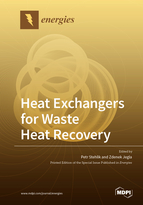Heat Exchangers for Waste Heat Recovery
A special issue of Energies (ISSN 1996-1073). This special issue belongs to the section "J: Thermal Management".
Deadline for manuscript submissions: closed (31 December 2019) | Viewed by 17261
Special Issue Editors
Interests: heat transfer and its application - thermal processing of waste including energy utilization (waste to energy); process furnaces and heat exchangers; process integration; energy savings and emissions reduction; simulation calculations and optimization in process industry; CFD applications
Special Issues, Collections and Topics in MDPI journals
Interests: applied and enhanced heat transfer; process and power heat transfer equipment (low-emission burners, combustion systems, process-fired heaters, boilers, heat exchangers); simulation, optimization, and CFD applications of heat transfer equipment in the process and power industry; process and equipment design and integration for energy savings and emissions reduction; thermal treatment and energy utilization of waste (waste-to-energy); energy savings and environmental protection
Special Issues, Collections and Topics in MDPI journals
Special Issue Information
Dear Colleagues,
The economical and efficient recovery of waste heat produced by industrial processes (such as chemical and petrochemical, food, pharmaceutical, energetics, etc.) and processes and applications in the municipal sphere (such as waste incinerators, heating plants, laundries, hospitals, server rooms, etc.) are priorities and challenges. This Special Issue focuses on heat exchangers as key and essential equipment for the practical realization of these challenges. The purpose of this Special Issue is to outline the latest insights and innovative and/or enhanced solutions from the design, production, operation, and maintenance points of view of the heat exchangers in different applications of effective waste heat utilization.
Prof. Petr Stehlik
Assoc. Prof. Zdenek Jegla
Guest Editors
Manuscript Submission Information
Manuscripts should be submitted online at www.mdpi.com by registering and logging in to this website. Once you are registered, click here to go to the submission form. Manuscripts can be submitted until the deadline. All submissions that pass pre-check are peer-reviewed. Accepted papers will be published continuously in the journal (as soon as accepted) and will be listed together on the special issue website. Research articles, review articles as well as short communications are invited. For planned papers, a title and short abstract (about 100 words) can be sent to the Editorial Office for announcement on this website.
Submitted manuscripts should not have been published previously, nor be under consideration for publication elsewhere (except conference proceedings papers). All manuscripts are thoroughly refereed through a single-blind peer-review process. A guide for authors and other relevant information for submission of manuscripts is available on the Instructions for Authors page. Energies is an international peer-reviewed open access semimonthly journal published by MDPI.
Please visit the Instructions for Authors page before submitting a manuscript. The Article Processing Charge (APC) for publication in this open access journal is 2600 CHF (Swiss Francs). Submitted papers should be well formatted and use good English. Authors may use MDPI's English editing service prior to publication or during author revisions.
Keywords
- Waste heat recovery
- Heat exchangers
- Economical and efficient applications
- Innovative designs of heat exchangers
- Enhanced heat transfer
- New materials for heat exchangers
- New approaches
- Systems or technologies to effective waste heat recovery.







